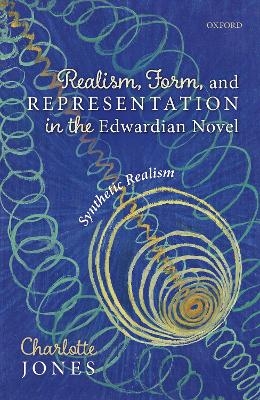
Realism, Form, and Representation in the Edwardian Novel
Synthetic Realism
Seiten
2021
Oxford University Press (Verlag)
978-0-19-885792-1 (ISBN)
Oxford University Press (Verlag)
978-0-19-885792-1 (ISBN)
Charts developments in literary realism between fin-de-siècle naturalism and early modernism by examining a wide range of realist novels from the Edwardian period, focusing in particular on works by Joseph Conrad, May Sinclair, Arnold Bennett, H.G. Wells, and Ford Madox Ford.
The real represents to my perception the things that we cannot possibly not know, sooner or later, in one way or another', wrote Henry James in 1907. This description, riven with double negatives, hesitation, and uncertainty, encapsulates the epistemological difficulties of realism, for underlying its narrative and descriptive apparatus as an aesthetic mode lies a philosophical quandary. What grounds the 'real' of the realist novel? What kind of perception is required to validate the experience of reality? How does the realist novel represent the difficulty of knowing? What comes to the fore in James's account, as in so many, is how the forms of realism are constituted by a relation to unknowing, absence, and ineffability.
Realism, Form, and Representation in the Edwardian Novel recovers a neglected literary history centred on the intricate relationship between fictional representation and philosophical commitment. It asks how--or if--we can conceptualize realist novels when the objects of their representational intentions are realities that might exist beyond what is empirically verifiable by sense data or analytically verifiable by logic, and are thus irreducible to conceptual schemes or linguistic practices--a formulation Charlotte Jones refers to as 'synthetic realism'.
In new readings of Edwardian novels including Conrad's Nostromo and The Secret Agent, Wells's Tono-Bungay, and Ford's The Good Soldier, this volume revises and reconsiders key elements of realist novel theory--metaphor and metonymy; character interiority; the insignificant detail; omniscient narration and free indirect discourse; causal linearity--to uncover the representational strategies by which realist writers grapple with the recalcitrance of reality as a referential anchor, and seek to give form to the force, opacity, and uncertain scope of realities that may lie beyond the material. In restoring a metaphysical dimension to the realist novel's imaginary, Realism, Form, and Representation in the Edwardian Novel offers a new conceptualization of realism both within early twentieth-century literary culture and as a transhistorical mode of representation.
The real represents to my perception the things that we cannot possibly not know, sooner or later, in one way or another', wrote Henry James in 1907. This description, riven with double negatives, hesitation, and uncertainty, encapsulates the epistemological difficulties of realism, for underlying its narrative and descriptive apparatus as an aesthetic mode lies a philosophical quandary. What grounds the 'real' of the realist novel? What kind of perception is required to validate the experience of reality? How does the realist novel represent the difficulty of knowing? What comes to the fore in James's account, as in so many, is how the forms of realism are constituted by a relation to unknowing, absence, and ineffability.
Realism, Form, and Representation in the Edwardian Novel recovers a neglected literary history centred on the intricate relationship between fictional representation and philosophical commitment. It asks how--or if--we can conceptualize realist novels when the objects of their representational intentions are realities that might exist beyond what is empirically verifiable by sense data or analytically verifiable by logic, and are thus irreducible to conceptual schemes or linguistic practices--a formulation Charlotte Jones refers to as 'synthetic realism'.
In new readings of Edwardian novels including Conrad's Nostromo and The Secret Agent, Wells's Tono-Bungay, and Ford's The Good Soldier, this volume revises and reconsiders key elements of realist novel theory--metaphor and metonymy; character interiority; the insignificant detail; omniscient narration and free indirect discourse; causal linearity--to uncover the representational strategies by which realist writers grapple with the recalcitrance of reality as a referential anchor, and seek to give form to the force, opacity, and uncertain scope of realities that may lie beyond the material. In restoring a metaphysical dimension to the realist novel's imaginary, Realism, Form, and Representation in the Edwardian Novel offers a new conceptualization of realism both within early twentieth-century literary culture and as a transhistorical mode of representation.
Charlotte Jones is Leverhulme Early Career Fellow in the School of English and Drama at Queen Mary, University of London.
Preface
Introduction
1: Joseph Conrad: The visible universe
2: May Sinclair: The Finding of the Absolute
3: Arnold Bennett: What Life is
4: H.G. Wells: More than history can pattern
5: Ford Madox Ford: Everything and nothing
Conclusion
| Erscheinungsdatum | 09.03.2021 |
|---|---|
| Verlagsort | Oxford |
| Sprache | englisch |
| Maße | 165 x 240 mm |
| Gewicht | 592 g |
| Themenwelt | Geisteswissenschaften ► Sprach- / Literaturwissenschaft ► Anglistik / Amerikanistik |
| Geisteswissenschaften ► Sprach- / Literaturwissenschaft ► Literaturgeschichte | |
| Geisteswissenschaften ► Sprach- / Literaturwissenschaft ► Literaturwissenschaft | |
| ISBN-10 | 0-19-885792-6 / 0198857926 |
| ISBN-13 | 978-0-19-885792-1 / 9780198857921 |
| Zustand | Neuware |
| Haben Sie eine Frage zum Produkt? |
Mehr entdecken
aus dem Bereich
aus dem Bereich
Poetik eines sozialen Urteils
Buch | Hardcover (2023)
De Gruyter (Verlag)
CHF 83,90
Buch | Softcover (2024)
belleville (Verlag)
CHF 27,95


